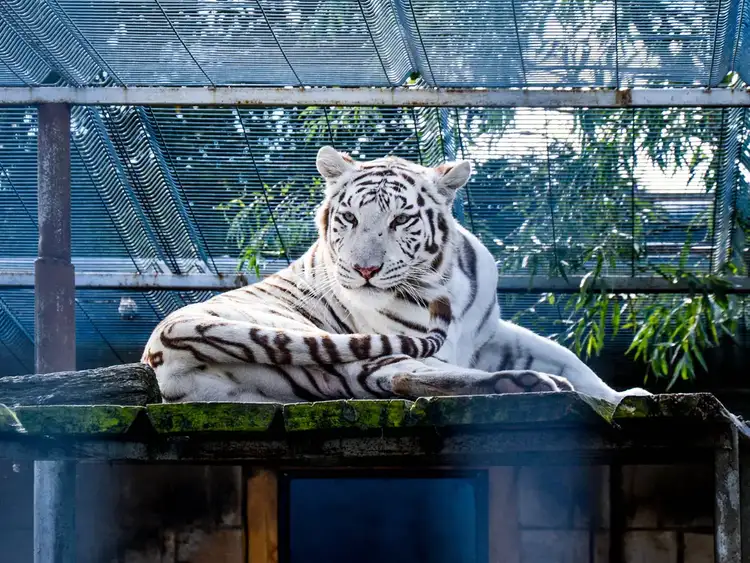MOVIE & LIFESTYLE NEWS
Discovering What Tigers Are White: The Fascinating World of White Tigers
White tigers are one of the most fascinating and unique creatures in the animal kingdom. These majestic animals have captivated people worldwide with their striking appearance and rarity. If you’ve ever wondered what tigers are white, let’s explore the origin of their unique color and what makes them so special with AlibayTrendy Store now
What Tigers Are White?
White tigers are among the most unique and visually striking members of the big cat family. They represent a rare color variation of the Bengal tiger (Panthera tigris tigris), distinguished by their white fur with dark stripes. This unique coloration sets them apart from the typical Bengal tigers, which usually have an orange coat adorned with black stripes.

The reason for their white fur comes down to a specific genetic mutation. This mutation results in a lack of the pigment pheomelanin, which typically gives Bengal tigers their vibrant orange color. Because of this genetic alteration, white tigers exhibit a captivating combination of white fur with contrasting black or dark brown stripes, making them a mesmerizing sight in both captivity and the wild.
White tigers are known for their rarity and often attract attention for their unusual and exotic appearance. However, their rarity in the wild and frequent presence in zoos and other controlled environments raise questions about their conservation and breeding practices.
The Genetic Basis of White Tigers
White tigers, though visually distinct, do not represent a separate species. They are a unique color morph of the Bengal tiger, arising from a specific genetic anomaly. The gene responsible for their white fur is known as the “recessive white” gene. This means that for a tiger to be born with white fur, both of its parents must carry this recessive gene.

Because the gene is recessive, the probability of white tigers appearing in the wild is quite low. Both parents need to possess and pass on the recessive white gene to produce a white tiger, making this color morph extremely rare. In the wild, where breeding occurs naturally, the odds of this specific combination are quite slim.
Due to this rarity, white tigers have become highly sought after in captivity, where breeding can be manipulated to increase the chances of producing them. This practice, however, has raised ethical concerns, as the need for both parents to carry the recessive gene often leads to inbreeding, which can result in various health issues and genetic complications for the tigers.
Despite their beauty, these issues underline the importance of focusing on conservation practices that prioritize the health and well-being of all tiger variants.
Are White Tigers Found in the Wild?
White tigers were once a rare but naturally occurring phenomenon in the wild, with the majority of sightings reported in the dense forests of India. These regions provided the ideal habitat for tigers, offering them a mix of dense cover and ample prey.

However, as human activity expanded into these areas, the natural environment for tigers began to shrink. Habitat loss due to deforestation and urbanization has had a devastating impact on wildlife, particularly large predators like tigers.
Additionally, poaching has contributed to the decline of tiger populations in the wild. Poachers often target tigers for their skins, bones, and other body parts, which are highly valued in some traditional medicines and on the black market.
The combined effect of habitat loss and poaching has pushed many tiger subspecies to the brink of extinction. Consequently, the presence of white tigers in their natural habitat has become exceedingly rare, if not nonexistent. Most of the white tigers today are found in captivity, in zoos, wildlife sanctuaries, and other controlled environments where they can be protected from these threats.
Breeding and Conservation of White Tigers
The breeding of white tigers in captivity is a practice that has generated significant controversy within the conservation community. As white tigers owe their unique color to a recessive gene, breeding them often requires close relatives to mate, leading to inbreeding.

This inbreeding can result in a host of genetic defects, such as weakened immune systems, skeletal deformities, and reduced fertility. These health issues not only cause suffering to the tigers but also raise ethical questions about the intention behind breeding white tigers.
Given these concerns, conservationists and wildlife experts generally focus their efforts on preserving the broader Bengal tiger population in the wild, rather than promoting the selective breeding of white tigers in captivity.
These efforts include establishing protected areas, enforcing anti-poaching laws, and working with local communities to reduce human-wildlife conflict. By prioritizing the conservation of Bengal tigers in their natural habitats, these initiatives aim to ensure the long-term survival of these magnificent creatures in a more ethical and sustainable manner.
While white tigers remain a captivating sight, their presence in captivity often comes at a significant cost. Supporting conservation efforts for all tiger subspecies is crucial for preserving these iconic animals for future generations.
The Appeal of White Tigers
White tigers possess a unique and mesmerizing beauty that continues to capture the imagination of people worldwide. Their stunning white coats adorned with bold black stripes give them a striking and exotic appearance, setting them apart from the typical orange-and-black-striped tigers.
This unique visual appeal has made white tigers a popular symbol in various forms of media, including books, movies, and folklore, where they often represent mystery, power, and elegance.

In popular culture, white tigers have been featured in a range of settings, from circus acts and magic shows to wildlife documentaries and animated films. This exposure has contributed to their iconic status, with people drawn to their rarity and distinctive look. They are often depicted as regal and majestic creatures, adding to their allure.
However, amidst the fascination with their appearance, it’s crucial to remember that white tigers are still tigers, with all the instincts, behaviors, and needs inherent to their species. They are powerful predators with sharp claws, strong jaws, and a keen sense of smell and hearing. This means that while they may look different, their behavior and natural instincts remain the same as those of their orange counterparts.
For this reason, it’s important to approach interactions with white tigers with caution and respect, recognizing that they are wild animals, even when kept in captivity. Efforts to breed white tigers solely for their appearance can lead to ethical concerns and health issues, emphasizing the need to appreciate these creatures while supporting conservation efforts that prioritize their well-being.
Ultimately, the appeal of white tigers lies in their striking visual impact and the sense of wonder they inspire. As we marvel at their beauty, it’s vital to remember the responsibilities that come with caring for these magnificent animals and to support conservation practices that ensure their continued survival in the most ethical and sustainable way.
White tigers are unique and awe-inspiring creatures that captivate our imagination. However, their existence raises crucial ethical and conservation-related questions. Understanding the genetic basis for their distinctive white coloration helps us appreciate their beauty while acknowledging the challenges of breeding them in captivity. To help ensure a sustainable future for all tigers, it’s important to focus on conserving their natural habitats and supporting ethical practices.
If you love the striking look of white tigers, why not wear it with pride? At AlibayTrendy Store, we offer a wide range of stylish Hawaiian shirts featuring bold tiger prints. Our Tiger Hawaiian Shirts are perfect for showing off your adventurous side while adding a touch of exotic flair to your wardrobe. Check out our collection today and find the perfect shirt to make a statement.
